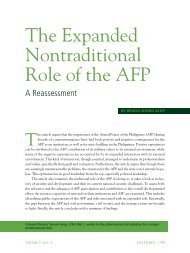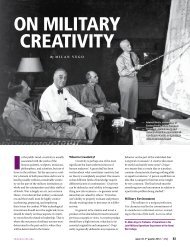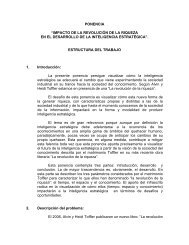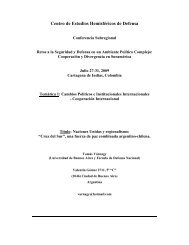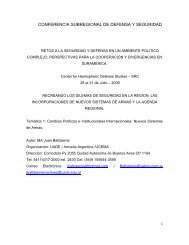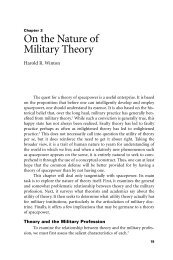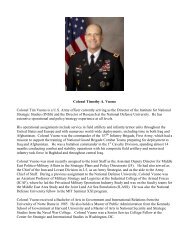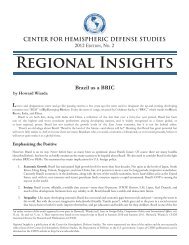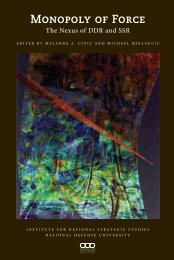In the second half of the 20th century, the US enjoyed pre-eminence ...
In the second half of the 20th century, the US enjoyed pre-eminence ...
In the second half of the 20th century, the US enjoyed pre-eminence ...
You also want an ePaper? Increase the reach of your titles
YUMPU automatically turns print PDFs into web optimized ePapers that Google loves.
instance, <strong>the</strong> U.S. S&T workforce must be able to quickly recognize movements in <strong>the</strong><br />
frontiers <strong>of</strong> knowledge and <strong>the</strong> potential for new military applications stemming from<br />
new knowledge or a combination <strong>of</strong> existing knowledge and new technology (i.e., avoid<br />
surprises and exploit quickly). A recent publication characterized S&T as involving two<br />
major phases: prospecting and mining. 17 Prospecting can be thought <strong>of</strong> as an activity that<br />
is important in <strong>the</strong> long term but shows little or no return on investment in <strong>the</strong> short term.<br />
Mining begins when prospecting has progressed to <strong>the</strong> point where sufficient<br />
understanding has been gained such that product (or system) development programs can<br />
begin using traditional return on investment metrics. 18 To maintain awareness, <strong>the</strong> U.S.<br />
S&T workforce must quickly spot <strong>the</strong> movement from one phase to ano<strong>the</strong>r; this is<br />
possible only through involvement in <strong>the</strong> appropriate prospecting phases. Spotting this<br />
movement was relatively easy for <strong>the</strong> United States and DOD 30 years ago, but it may be<br />
more challenging now as <strong>the</strong> largest share <strong>of</strong> all prospecting advances occurs outside <strong>of</strong><br />
<strong>the</strong> United States. A simple example <strong>of</strong> a new challenge is that much <strong>of</strong> <strong>the</strong> work may be<br />
reported in languages o<strong>the</strong>r than English.<br />
• Prepare for <strong>the</strong> war after next. <strong>In</strong> many ways, this is where DOD S&T has a key role to<br />
play. The activity here is well beyond <strong>the</strong> horizon <strong>of</strong> current military requirements, and<br />
<strong>the</strong> timescales involved are typical <strong>of</strong> S&T (e.g., 10–20 years) that includes a prospecting<br />
phase. This activity involves developing future capabilities scenarios, alternatives, and<br />
likelihoods based on estimates <strong>of</strong> technology trends and new knowledge gains foreseen in<br />
<strong>the</strong> research and exploitation pipelines. It plays an important part in determining areas for<br />
S&T investments, motivating discovery and invention, and involving <strong>the</strong> larger S&T<br />
community so it is <strong>pre</strong>pared to contribute to <strong>the</strong> required efforts when needed. Playing in<br />
this area requires highly talented and respected S&Es. A growing challenge here is<br />
attracting such individuals to participate when most S&T is being done outside <strong>of</strong> DOD.<br />
• <strong>In</strong>vest in S&T exploration. The U.S. Government, including DOD, has a strong record <strong>of</strong><br />
investing in research at <strong>the</strong> frontiers <strong>of</strong> S&T (prospecting) to foster <strong>the</strong> discovery <strong>of</strong> new<br />
knowledge. DOD is unusual with regard to federal funding <strong>of</strong> S&T efforts in that it may<br />
also be <strong>the</strong> user <strong>of</strong> <strong>the</strong> results <strong>of</strong> its S&T efforts. Numerous examples <strong>of</strong> this scenario are<br />
found in military systems (e.g., radar, sonar, missiles, aircraft). One cannot expect o<strong>the</strong>r<br />
sources (e.g., industry) to invest significantly here, and studies indicate this is<br />
increasingly <strong>the</strong> purview <strong>of</strong> governments as industry looks to early returns on its R&D<br />
investments. 19 Many use <strong>the</strong> term “curiosity-driven” to describe this activity, but<br />
“knowledge-driven” seems more appropriate to <strong>the</strong> actual motivations <strong>of</strong> both <strong>the</strong><br />
researchers and <strong>the</strong> sponsors. <strong>In</strong> an era <strong>of</strong> much broader global S&T, <strong>the</strong> U.S. share <strong>of</strong><br />
exploration will be less. This <strong>pre</strong>sents <strong>the</strong> nation and especially DOD with a dilemma: <strong>the</strong><br />
reduced share suggests a narrowing <strong>of</strong> topics in which S&T investments are made, but<br />
<strong>the</strong> mission requires that awareness cover all areas <strong>of</strong> <strong>the</strong> global S&T program.<br />
Resolution <strong>of</strong> this dilemma may require new approaches for investing in S&T.<br />
• Discover things. An S&T portfolio ranging from exploration to application-driven<br />
investments is barren without frequent successes in <strong>the</strong> nature <strong>of</strong> discovery. Successes<br />
17 The S&T <strong>In</strong>novation Conundrum, T. C<strong>of</strong>fey, J. Dahlburg, and E. Zimet, National Defense University (NDU)<br />
Defense & Technology Paper Number 17 (2005).<br />
18 Avoiding Technology Surprise for Tomorrow’s Warfighter: A Symposium Report, NRC (2009).<br />
19 OECD Science, Technology, and <strong>In</strong>dustry Outlook 2010.<br />
13



